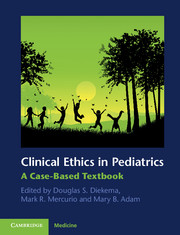Book contents
- Frontmatter
- Contents
- Contributors
- Preface
- Section 1 Core issues in clinical pediatric ethics
- Section 2 Ethical issues at the beginning of life: perinatology and neonatology
- Section 3 When a child dies: ethical issues at the end of life
- Section 4 Ethical issues posed by advances in medical technology and science
- 25 Minors as recipients and donors in solid organ transplantation
- 26 Enhancement technologies and children
- 27 Cochlear implants and deaf children
- 28 Ethical issues in the treatment of pediatric patients with disorders of sex development
- 29 Sterilizing procedures in minors with cognitive disabilities
- 30 Parental requests for intervention in children with lethal conditions
- 31 Genetic testing and screening of minors
- 32 The introduction of innovative technology into practice
- 33 Human subjects research involving children
- Section 5 Children, public health, and justice
- Section 6 Special topics in pediatric ethics
- Index
- References
28 - Ethical issues in the treatment of pediatric patients with disorders of sex development
from Section 4 - Ethical issues posed by advances in medical technology and science
Published online by Cambridge University Press: 07 October 2011
- Frontmatter
- Contents
- Contributors
- Preface
- Section 1 Core issues in clinical pediatric ethics
- Section 2 Ethical issues at the beginning of life: perinatology and neonatology
- Section 3 When a child dies: ethical issues at the end of life
- Section 4 Ethical issues posed by advances in medical technology and science
- 25 Minors as recipients and donors in solid organ transplantation
- 26 Enhancement technologies and children
- 27 Cochlear implants and deaf children
- 28 Ethical issues in the treatment of pediatric patients with disorders of sex development
- 29 Sterilizing procedures in minors with cognitive disabilities
- 30 Parental requests for intervention in children with lethal conditions
- 31 Genetic testing and screening of minors
- 32 The introduction of innovative technology into practice
- 33 Human subjects research involving children
- Section 5 Children, public health, and justice
- Section 6 Special topics in pediatric ethics
- Index
- References
Summary
Case narrative 1
Julie G, a 26-year-old banker, has a normal first pregnancy and goes into labor at 41 weeks. All proceeds normally. Her husband stays with her in the delivery room and she has the baby at approximately 4 a.m. When the obstetrician delivers the baby, she indicates that the infant is a boy. Later that morning, a pediatrician from the practice Julie and her husband have chosen arrives to speak with them and examine the newborn. She notices the urethral opening is at the base of the phallic shaft and the phallus seems somewhat short. She wonders if the child might have a disorder of sex development (DSD). Specifically, she wonders if the child might have normal female chromosomes and some form of virilizing congenital adrenal hyperplasia (CAH) – a relatively common form of DSD.
Dr. P sits down with the parents. She explains what she has observed and what it might mean. She emphasizes that the baby appears otherwise entirely normal and should be healthy, unless the child has a form of CAH with disturbed regulation of the body’s important minerals. Both parents want to know whether their baby is “really” a boy or a girl. They have questions about picking a name for the child, what to tell those close to them, and what treatment the child will need.
- Type
- Chapter
- Information
- Clinical Ethics in PediatricsA Case-Based Textbook, pp. 160 - 165Publisher: Cambridge University PressPrint publication year: 2011



